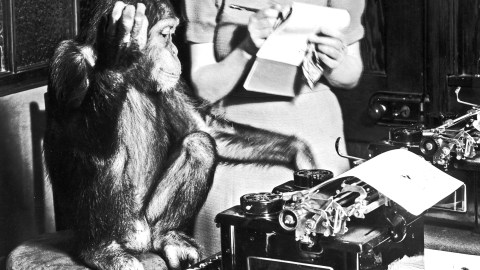Why New Brain-Sensing Technology Lets Monkeys Type Shakespeare

The infinite monkey theorem states that given enough monkeys and time, even while typing randomly, sooner or later the monkeys will type up the full works of Shakespeare and pretty much everything else ever written. This fun idea saw a partial incarnation courtesy of scientists at Stanford University who released a new study, promisingly titled “A Nonhuman Primate Brain–Computer Typing Interface“. They didn’t create a play-writing genius monkey, but they did get monkeys to type Shakespeare. Oh, and they typed with their minds.
Are these monkeys now speaking English? No. But the technology being researched is quite exciting. Its stated goal is to help very paralyzed people communicate.
The technology that was developed by Stanford’s Professor Krishna Shenoy and postdoctoral scholar Paul Nuyujukian reads brain signals in order to drive a cursor that’s moving over a keyboard.
The two monkeys studied were first taught to point to patterns of on-screen yellow and green dots, which flashed to spell out specific letters. Then the monkeys were outfitted with electrode implants in their brains (in the part that controls movement). The subjects were then shown patterns of letters (flashing dots), which spelled out texts from “Hamlet” and passages from New York Times.
The arrays were able to measure corresponding brain activity each time a monkey thought of the where to point its arm, which it previously learned to point to the next letter to spell. The monkeys were able to achieve typing speeds of 12 words per minute, three times the highest brain-based typing rate ever.
“Our results demonstrate that this interface may have great promise for use in
people,” said Nuyujukian. “It enables a typing rate sufficient for a meaningful
conversation.”
Being able to read brain signals directly would help overcome a number of challenges presented by current typing technologies for the disabled. Stephen Hawking, for example, couldn’t use eye-tracking software because of his drooping eyelids.
The new tech is now moving to a clinical trial, with the scientists sounding confident.
“The interface we tested is exactly what a human would use,” said Nuyujukian, “What we had never quantified before was the typing rate that could be achieved.”
While they are excited about the typing rate achieved by the monkeys, they think that humans would probably type somewhat slower.





